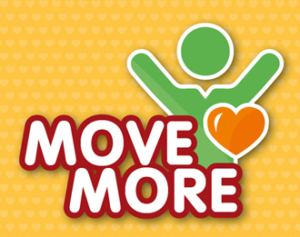
THE CHALLENGE: Get active every day – move more!
Why is it important to get active and move more?
Physical activity is beneficial because it can:
- help to manage the balance between energy in and energy out, to maintain a healthy weight
- improve heart health and strengthen muscles and bones
- improve sleep, relieve stress and lift mood
How active do we need to be?
We are all advised to minimise inactivity. In addition, there are specific age-related recommendations. When we are moving more, it is still important to stick to the social distancing and exercise guidelines from the Government. To find these guidelines, click here.
Pre-schoolers (aged 3 to 4)
- Be active for 180 minutes (3 hours) spread throughout the day, including at least 60 minutes of moderate-to-vigorous intensity physical activity
Children and young people (aged 5 -18 years)
- Be active for at least 60 minutes every day (ranging from moderate-to-vigorous intensity)
- Engage in a variety of types and intensities of physical activity across the week, to develop movement skills, muscular fitness and bone strength
Adults (19 – 64 years)
- Be active for at least 150 minutes each week (moderate intensity), or have 75 minutes of vigorous activity a week
- Do muscle strengthening activities on two days or more each week
Inactivity
As well as increasing your physical activity levels, it is also important to be aware of the amount of time you spend being sedentary (sitting or lying down – sleeping doesn’t count). Many jobs involve sitting in an office for long periods of time, and leisure time is often spent watching television or using a screen, such as browsing the web or playing computer games. Try not to spend long periods of time sitting down – get up and move around from time to time, and think of alternative more active ways to spend your leisure time
Get involved
The best way to move more is to incorporate activity into daily life. Making small changes can have a bit impact on your physical and mental health. You don’t need to be out walking for miles or spending hours in the gym to make a difference.
- Walking as your means of active transport – leave the car at home for short journeys, try walking to work and taking the stairs instead of the lift
- Walking for leisure – Go for a brisk 10 minute walk at lunchtime and again after dinner, walking with friends and exploring your local surroundings or join the CRF Walking Group (contact us at ECRF.Sustainability@ed.ac.uk for more info)
- Activity at home – gardening and housework can count towards your physical and strength exercise goals. Exercise videos, apps and games are another great way to fit activities into your day without having to go to an organised session
You can find more information about how to incorporate activities into your daily life here – https://www.nutrition.org.uk/healthyliving/an-active-lifestyle/







If anyone wants to up their exercise, I am getting a tonne of logs delivered on Tuesday evening that will need stacking … Does that count as a new activity?